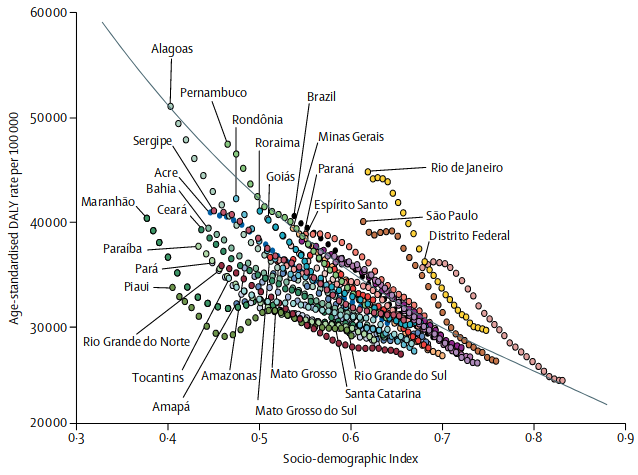Burden of disease in Brazil, 1990–2016: a systematic subnational analysis for the Global Burden of Disease Study 2016

Reference
Abstract
Background
Political, economic, and epidemiological changes in Brazil have affected health and the health system. We used the Global Burden of Disease Study 2016 (GBD 2016) results to understand changing health patterns and inform policy responses.
Methods
We analysed GBD 2016 estimates for life expectancy at birth (LE), healthy life expectancy (HALE), all-cause and cause-specific mortality, years of life lost (YLLs), years lived with disability (YLDs), disability-adjusted life-years (DALYs), and risk factors for Brazil, its 26 states, and the Federal District from 1990 to 2016, and compared these with national estimates for ten comparator countries.
Findings
Nationally, LE increased from 68·4 years (95% uncertainty interval [UI] 68·0–68·9) in 1990 to 75·2 years (74·7–75·7) in 2016, and HALE increased from 59·8 years (57·1–62·1) to 65·5 years (62·5–68·0). All-cause agestandardised mortality rates decreased by 34·0% (33·4–34·5), while all-cause age-standardised DALY rates decreased by 30·2% (27·7–32·8); the magnitude of declines varied among states. In 2016, ischaemic heart disease was the leading cause of age-standardised YLLs, followed by interpersonal violence. Low back and neck pain, sense organ diseases, and skin diseases were the main causes of YLDs in 1990 and 2016. Leading risk factors contributing to DALYs in 2016 were alcohol and drug use, high blood pressure, and high body-mass index.
Interpretation
Health improved from 1990 to 2016, but improvements and disease burden varied between states. An epidemiological transition towards non-communicable diseases and related risks occurred nationally, but later in some states, while interpersonal violence grew as a health concern. Policy makers can use these results to address health disparities.
Funding
Bill & Melinda Gates Foundation and the Brazilian Ministry of Health.